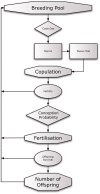The case of Moulay Ismael--fact or fancy? - PubMed (original) (raw)
The case of Moulay Ismael--fact or fancy?
Elisabeth Oberzaucher et al. PLoS One. 2014.
Abstract
Textbooks on evolutionary psychology and biology cite the case of the Sharifian Emperor of Morocco, Moulay Ismael the Bloodthirsty (1672-1727) who was supposed to have sired 888 children. This example for male reproduction has been challenged and led to a still unresolved discussion. The scientific debate is shaped by assumptions about reproductive constraints which cannot be tested directly-and the figures used are sometimes arbitrary. Therefore we developed a computer simulation which tests how many copulations per day were necessary to reach the reported reproductive outcome. We based our calculations on a report dating 1704, thus computing whether it was possible to have 600 sons in a reproductive timespan of 32 years. The algorithm is based on three different models of conception and different social and biological constraints. In the first model we used a random mating pool with unrestricted access to females. In the second model we used a restricted harem pool. The results indicate that Moulay Ismael could have achieved this high reproductive success. A comparison of the three conception models highlights the necessity to consider female sexual habits when assessing fertility across the cycle. We also show that the harem size needed is far smaller than the reported numbers.
Conflict of interest statement
Competing Interests: The authors have declared that no competing interests exist.
Figures
Figure 1. This figure illustrates the setup of the simulation—circles indicate factors negatively affecting reproductive success, rectangles indicate factors increasing reproductive success.
Figure 2. The potential reproductive outcome is related to the harem size.
Saturation is reached at smaller harem sizes for the Wilcox-Weinberg and Barrett-Marshall models than for the Jöchle model.
Similar articles
- Genetic mating system and the significance of harem associations in the bat Saccopteryx bilineata.
Heckel G, Von Helversen O. Heckel G, et al. Mol Ecol. 2003 Jan;12(1):219-27. doi: 10.1046/j.1365-294x.2003.01722.x. Mol Ecol. 2003. PMID: 12492890 - "Nice guys finish last": influence of mate choice on reproductive success in Long-Evans rats.
Winland C, Bolton JL, Ford B, Jampana S, Tinker J, Frohardt RJ, Guarraci FA, Zewail-Foote M. Winland C, et al. Physiol Behav. 2012 Feb 1;105(3):868-76. doi: 10.1016/j.physbeh.2011.10.022. Epub 2011 Oct 26. Physiol Behav. 2012. PMID: 22064017 - Computer modeling of human fertility: the impact of reproductive heterogeneity on measures of fertility.
Mattison DR, Brewer DW. Mattison DR, et al. Reprod Toxicol. 1988;2(3-4):253-71. Reprod Toxicol. 1988. PMID: 2980356 Review. - Sexual selection: harem size and the variance in male reproductive success.
Wade MJ, Shulter SM. Wade MJ, et al. Am Nat. 2004 Oct;164(4):E83-9. doi: 10.1086/424531. Epub 2004 Aug 19. Am Nat. 2004. PMID: 15459886 - An integrative view of sexual selection in Tribolium flour beetles.
Fedina TY, Lewis SM. Fedina TY, et al. Biol Rev Camb Philos Soc. 2008 May;83(2):151-71. doi: 10.1111/j.1469-185X.2008.00037.x. Biol Rev Camb Philos Soc. 2008. PMID: 18429767 Review.
Cited by
- Power and Autistic Traits.
Overskeid G. Overskeid G. Front Psychol. 2016 Aug 31;7:1290. doi: 10.3389/fpsyg.2016.01290. eCollection 2016. Front Psychol. 2016. PMID: 27630593 Free PMC article. - Understanding variation in human fertility: what can we learn from evolutionary demography?
Sear R, Lawson DW, Kaplan H, Shenk MK. Sear R, et al. Philos Trans R Soc Lond B Biol Sci. 2016 Apr 19;371(1692):20150144. doi: 10.1098/rstb.2015.0144. Philos Trans R Soc Lond B Biol Sci. 2016. PMID: 27022071 Free PMC article. Review.
References
- Einon D (1995) How many children can one man have? EHB 19: 413–426.
- Gould RG (2000) How many children Moulay Ismael should have had? EHB 21: 295–296.
- France JT, Graham FM, Gosling L, Hair P, Knox BS (1992) Characteristics of natural conceptual cycles occurring in a prospective study of sex preselection: fertility awareness, symptoms, hormone levels, sperm survival and pregnancy outcome. Int J Fertil 37: 244–255. - PubMed
- Harlow SD (2000) Menstruation and menstrual disorders: the epidemiology of menstruation and menstrual dysfunction. In: Goldman M, Hatch M, editors. Women and Health. Academic Press, San Diego, CA. pp. 99–113.
Publication types
MeSH terms
Personal name as subject
Grants and funding
The authors have no support or funding to report.
LinkOut - more resources
Full Text Sources
Other Literature Sources

